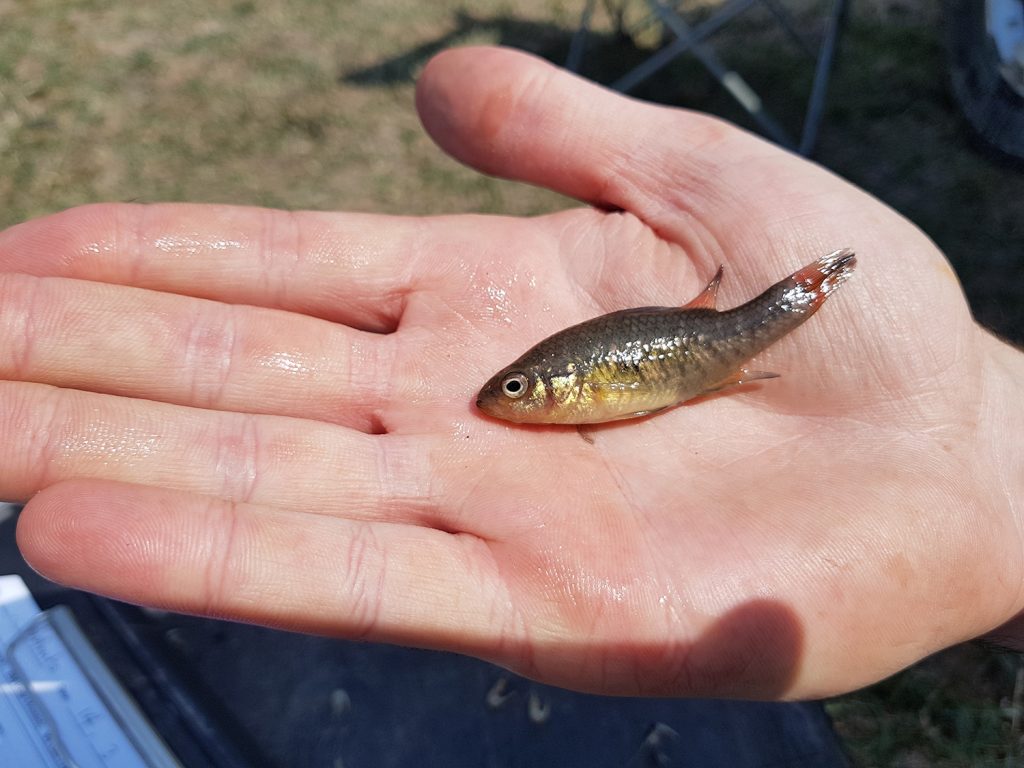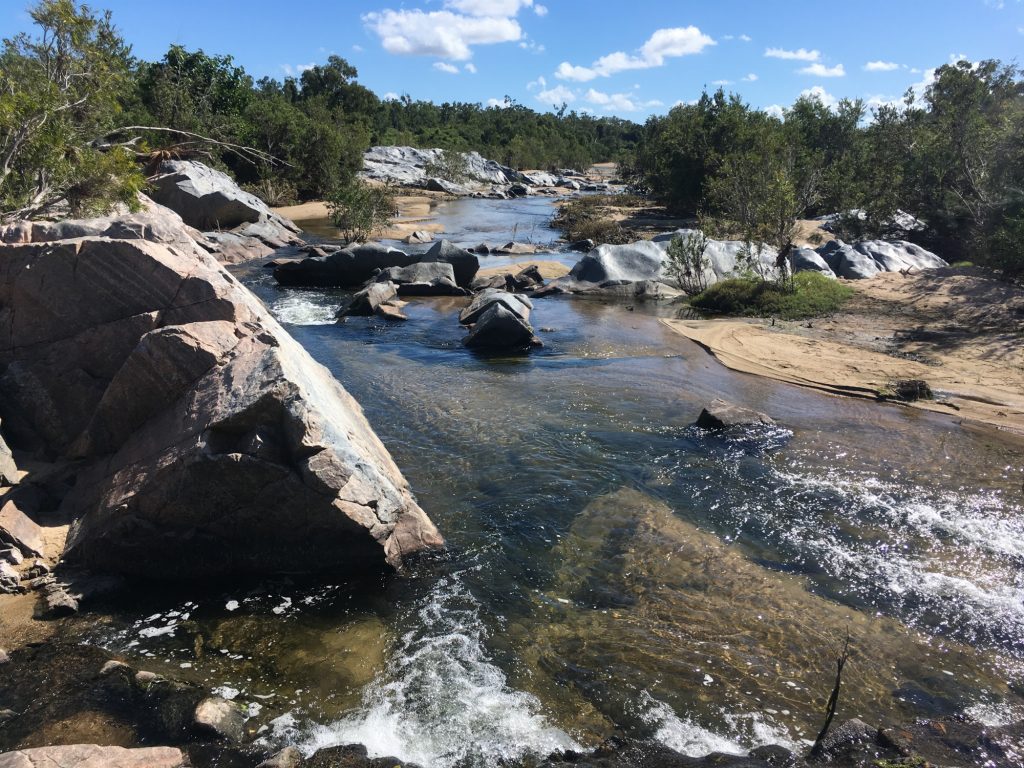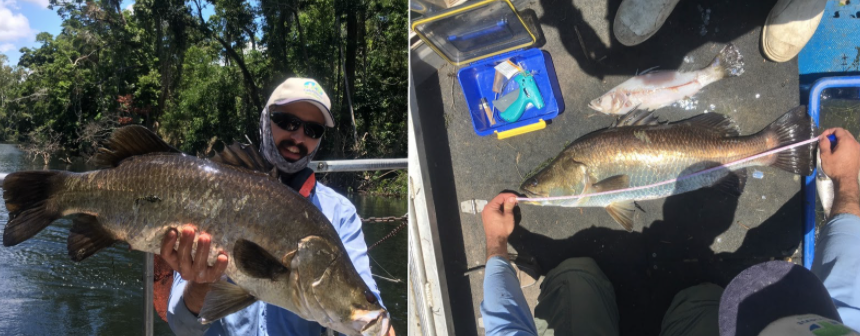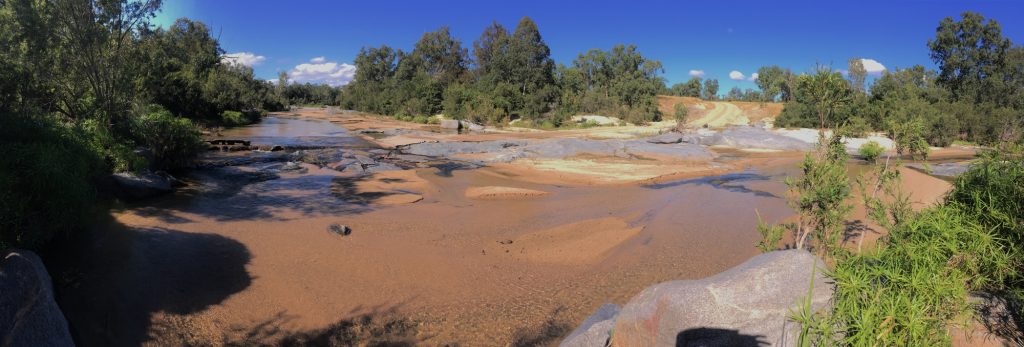
Having pride. Taking part.
Northern Queensland is renowned for its stunning coastal views, incredible wildlife and of course the iconic Great Barrier Reef. The local community in the Mackay-Whitsunday-Isaac (MWI) region is proud of this natural heritage.
But how do we track the health of these natural environments and waterways? In 2014, the community realised that we were “in the dark” when it came to understanding our local environmental wellbeing. The Healthy Rivers to Reef Partnership (HR2RP) was formed to get a better understanding of waterway health through the development of an annual waterway health report card. As a community we recognise that taking care of our environment, our home, takes a joint effort. Everyone plays a part.
A key question that our community has rightfully raised: if we can see lots of large fish, platypus and other wildlife in our lakes, rivers and creeks – are the pesticides in our waterways really a problem? Here we unpack what is happening with freshwater fish and the impacts of pesticides in our region.
Pesticide impacts go beyond what you can see.
 Pictured: Photo by Catchment Solutions of the Don River when HR2RP did its last rounds of fish barrier assessments.
Pictured: Photo by Catchment Solutions of the Don River when HR2RP did its last rounds of fish barrier assessments.
With the naked eye, it can be difficult to see the full impact of pesticides on our ecosystems. This is because the organisms most at risk from pesticides used today are smaller species such as aquatic plants and algae, as well as insects and crustaceans.
Studies in our region have found that one of the most prominent pesticides found in local waters, diuron, is found in concentrations high enough to harm numerous species of aquatic plants and algae. What’s more, there is also evidence suggesting that concentrations of insecticides are high enough to harm invertebrates (like insects and crustaceans) that call our ‘backyard’ creeks and rivers home. The fact that these small organisms are the ones most affected makes it harder to see potential impacts on the ecosystem.
These small organisms play very important roles in aquatic habitats, with many fish and other species depending on them for food and shelter. By the time changes in fish populations are realised, potentially irreversible negative impacts to the aquatic plants, insects or crustaceans in the ecosystem may have already occurred. If we want to protect the fish and other species that depend on those organisms, we need to prevent those large and potentially irreversible impacts.
Pesticides can be harmful to our waterways.
So how do we work out if those plants, insects and crustaceans are being affected if it’s truly hard to observe? We do this by collecting water samples and looking at the number, types and concentrations of pesticides found in rivers and creeks. By comparing the concentrations we measure in rivers against concentrations proven to affect organisms in laboratory tests, we can estimate whether the concentrations in the rivers are high enough to cause an effect on similar organisms inhabiting the river.
The Great Barrier Reef Catchment Loads Monitoring Program has monitored pesticides in Mackay Whitsunday creeks and rivers since 2009. We know that pesticides aren’t a problem everywhere, but in some catchments they are high enough (and for long enough) to cause an impact to aquatic plants, insects and crustaceans. This data is presented annually in the Mackay-Whitsunday-Isaac Healthy Rivers to Reef Partnership Regional Report Card.
These are just a few examples, but the 2017 Scientific Consensus Statement, written by 48 scientific experts, has brought together the best-available scientific evidence on the ways that these chemicals negatively impact our waterways. The conclusion? Pesticides are a key threat to many of our local freshwater rivers and basins, as well as some inshore and coastal habitats.
How we measure fish health in the HR2RP Report Card.
Fish surveys in our basins are undertaken by the Department of Environment and Science every year. These results are reported in the Partnership’s report card. Currently the freshwater fish score for our region is ‘good’ and ‘very good’ across all catchments. Moreover, a recent report from the Department of Agriculture and Fisheries found 85% of key Queensland fish stocks were assessed as showing no sustainability concerns. Based on these results, the important question remains; if pesticides are at harmful concentrations, why are we getting these positive fish scores?
 Pictured: HR2RP supports fish monitoring programs in the Isaac, Mackay and Whitsunday Region. This Barramundi measurement was photographed by Catchment Solutions.
Pictured: HR2RP supports fish monitoring programs in the Isaac, Mackay and Whitsunday Region. This Barramundi measurement was photographed by Catchment Solutions.
But what about the positive fish scores?
This is a complicated question, but basically it comes down to the fact that pesticides are not designed specifically to kill fish, but rather are made to kill insects and plants. Insecticides can also harm crustaceans (e.g. prawns, crabs, yabbies) that are closely related to insects.
1. Pesticides are not designed to kill fish.
The concentrations needed to affect fish are generally higher than those needed to affect insects, crustaceans, aquatic plants and algae. For example, fish start to experience toxic effects from diuron at concentrations 20 times higher (on average) than the concentrations that cause toxic effects in aquatic plants and algae. For imidacloprid, fish start to experience toxic effects at concentrations about 90 times higher (on average) than those that harm aquatic crustaceans and insects1.
2. It’s about concentration and the type of impact.
So, unless pesticide concentrations are very high, it is unlikely that fish will be directly killed by the majority of common pesticides used today. However, the fish we see in our streams, rivers and lakes feed on these aquatic plants, algae, insects and crustaceans, meaning pesticides may indirectly affect fish by reducing the amount of their food and/or their habitat. A recent study in Japan showed the potential for indirect effects of pesticides. They found that one year after imidacloprid was first applied to rice, the mass of zooplankton (small floating or weakly swimming organisms that drift with water currents) in a lake that received water from the rice fields decreased by 83%. At the same time there were large declines in the annual harvest of two commercial fish that eat zooplankton. Comparatively there was no effect on the harvest of another commercial fish that predominantly eats algae. Neither the zooplankton nor the two fish that eat zooplankton had recovered, even10 years on. However, this being said, the impacts of pesticides on animals and plants lower in the food chain don’t always translate to a noticeable impact on large fish further up the food chain – like barramundi.
3. Measuring fish numbers and health.
Another factor is that the fish grade in the HR2RP report card measures the number of pest fish and native fish species. While this gives us an indication of the overall health of fish populations in the region, we don’t look at all aspects of individual fish health. It’s possible for pesticides to still affect the size, age, reproduction and health of our fish – all while recording a positive grade.
Regarding questions raised on the reporting of fish stocks in our region, we sought advice from Fisheries Queensland to clarify the purpose of the fisheries sustainability measures presented in the DAF annual report. Here’s what we learned:
The measures presented in the annual report show a number of outcomes of the national Status of Australian Fish Stocks (SAFS) program. The SAFS program classifies the sustainability status of nationally important recreational and commercial fisheries resources including fish, prawns, crabs, and other target species. However, the SAFS program does not:
1. assess any non-target or small-bodied fish species;
2. includes specific data on fish health;
3. report on the fish living within a catchment or at a local scale. Instead, the program reports the status of fish stocks across the entire area where each species lives.
Statistics presented in the DAF Annual Report and the SAFS reports are really designed to show the effectiveness of existing fisheries regulatory frameworks. As a result, the reports add little value when looking at the potential effects of pesticide accumulation on the wide variety of fish and other aquatic species that live in our basins and estuaries.
Acknowledging the data gap in pesticides vs. fish.
We really care about taking care of our backyard and getting better answers about pesticide impacts. This is why the Healthy Rivers to Reef Partnership has funded an estuary pesticide monitoring program, which when combined with existing monitoring in the region, tests pesticide concentrations in over 200 water samples across 8 estuaries in our region every year.
However, HR2RP acknowledges that there are gaps in the data we report. There is more work to be done, and it’s our goal to report on the impacts of pesticides on fish in our region’s basins in the future. To address this, we need a specialised science called ecotoxicology, which examines the effects of pollutants on individual species, populations, communities and ecosystems.
This kind of research requires a concerted effort, so our Partnership is working toward answering this question by working with the Queensland Government and universities. A workshop involving fish and ecotoxicology experts is being organised by HR2RP in collaboration with the University of Queensland. We recognise that farmers and our broader community have been working hard to protect our waterways and our Partnership is working hard to provide more useful insights into the health of our waterways and prized fish.
Getting ecotoxicology reporting off the ground.
HR2RP is looking to get ecotoxicology reporting off the ground to get better visibility into the health of our fish and impact of pesticides. If you’d like to be involved or support this research, please register your interest by emailing info@healthyriverstoreef.org.
Words by: Talen Rimmer
References:
Department of Agriculture and Fisheries. 2019. 2018-2019 Annual Report. Queensland Government. Retrieved from: https://www.daf.qld.gov.au/strategic-direction/annual-report
Magnusson, M., Heimann, K., and Negri, A. 2008. Comparative Effects of Herbicides on Photosynthesis and Growth of Tropical Estuarine Microalgae. Marine Pollution Bulletin 56 (2008) 1545-1552. DOI: https://doi.org/10.1016/j.marpolbul.2008.05.023
C. King, R. A. Smith, R. M. Mann and M. St. J. Warne. 2017. Proposed aquatic ecosystem protection guideline values for pesticides commonly used in the Great Barrier Reef catchment area: Part 1 (amended) 2,4-D, Ametryn, Diuron, Glyphosate, Hexazinone, Imazapic, Imidacloprid, Isoxaflutole, Metolachlor, Metribuzin, Metsulfuron-methyl, Simazine, Tebuthiuron. Department of Environment and Science. Brisbane, Queensland, Australia. 296 pp.
Schaffelke, B., Collier, C., Kroon, F., Lough, J., McKenzie, L., Ronan, M., Uthicke, S., Brodie, J., 2017. Scientific Consensus Statement 2017. Scientific Consensus Statement 2017: A synthesis of the science of land-based water quality impacts on the Great Barrier Reef, Chapter 1: The condition of coastal and marine ecosystems of the Great Barrier Reef and their responses to water quality and disturbances. State of Queensland, 2017.
Rohr, J., Crumrine, P. 2005. Effects of Herbicide and an insecticide on pond community structure and processes. https://doi.org/10.1890/03-5353
Stone, S., Adams, M.S., Stauber, J.L., Jolley, D.F., Warne, M. St J. 2019. Development and Application of a multispecies toxicity test with tropical freshwater microalgae. Environmental Pollution 250 (2019) 97-106.
Yamamuro M, Komuro T, Kamiya H, Kato T, Hasegawa H and Kameda Y. 2019. Neonicitinoids disrupt aquatic food webs and decrease fishery yields. Science, 366, 620–633. DOI: 10.1126/science.aax3442
Acknowledgements:
The Healthy Rivers to Reef Partnership would like to thank all the waterway experts who helped contribute to this article, including Dr Rachael Smith (Department of Environment and Science) and Assoc. Professor Michael Warne (University of Queensland).




